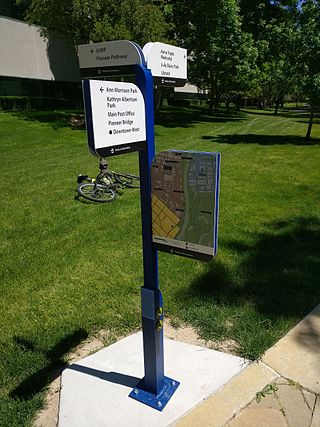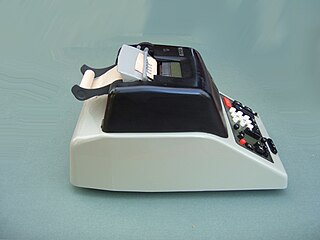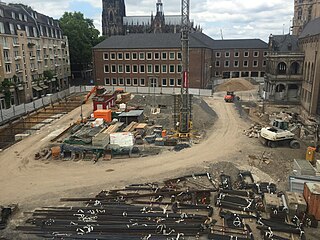
An architect is a person who plans, designs, and oversees the construction of buildings. To practice architecture means to provide services in connection with the design of buildings and the space within the site surrounding the buildings that have human occupancy or use as their principal purpose. Etymologically, the term architect derives from the Latin architectus, which derives from the Greek, i.e., chief builder.

A prototype is an early sample, model, or release of a product built to test a concept or process. It is a term used in a variety of contexts, including semantics, design, electronics, and software programming. A prototype is generally used to evaluate a new design to enhance precision by system analysts and users. Prototyping serves to provide specifications for a real, working system rather than a theoretical one. Physical prototyping has a long history, and paper prototyping and virtual prototyping now extensively complement it. In some design workflow models, creating a prototype is the step between the formalization and the evaluation of an idea.

An application-specific integrated circuit is an integrated circuit (IC) chip customized for a particular use, rather than intended for general-purpose use, such as a chip designed to run in a digital voice recorder or a high-efficiency video codec. Application-specific standard product chips are intermediate between ASICs and industry standard integrated circuits like the 7400 series or the 4000 series. ASIC chips are typically fabricated using metal–oxide–semiconductor (MOS) technology, as MOS integrated circuit chips.

Industrial design is a process of design applied to physical products that are to be manufactured by mass production. It is the creative act of determining and defining a product's form and features, which takes place in advance of the manufacture or production of the product. Industrial manufacture consists of predetermined, standardized and repeated, often automated, acts of replication, while craft-based design is a process or approach in which the form of the product is determined personally by the product's creator largely concurrent with the act of its production.

Construction is a general term meaning the art and science of forming objects, systems, or organizations. It comes from the Latin word constructio and Old French construction. To 'construct' is a verb: the act of building, and the noun is construction: how something is built or the nature of its structure.

A scale model is a physical model that is geometrically similar to an object. Scale models are generally smaller than large prototypes such as vehicles, buildings, or people; but may be larger than small prototypes such as anatomical structures or subatomic particles. Models built to the same scale as the prototype are called mockups.
Video game development is the process of creating a video game. It is a multidisciplinary practice, involving programming, design, art, audio, user interface, and writing. Each of those may be made up of more specialized skills; art includes 3D modeling of objects, character modeling, animation, visual effects, and so on. Development is supported by project management, production, and quality assurance. Teams can be many hundreds of people, a small group, or even a single person.

A studio is an artist or worker's workroom. This can be for the purpose of acting, architecture, painting, pottery (ceramics), sculpture, origami, woodworking, scrapbooking, photography, graphic design, filmmaking, animation, industrial design, radio or television production broadcasting or the making of music and financial services administration. The term is also used for the workroom of dancers, often specified to dance studio.
Product design is the process of creating new products for sale businesses to its customers. It involves the generation and development of ideas through a systematic process that leads to the creation of innovative products. Thus, it is a major aspect of new product development.
A design engineer is an engineer focused on the engineering design process in any of the various engineering disciplines and design disciplines like Human-Computer Interaction. Design engineers tend to work on products and systems that involve adapting and using complex scientific and mathematical techniques. The emphasis tends to be on utilizing engineering physics and other applied sciences to develop solutions for society.

OKB is a transliteration of the Russian initials of "опытно-конструкторское бюро" – opytno konstruktorskoye byuro, meaning 'experiment and design bureau'. During the Soviet era, OKBs were closed institutions working on design and prototyping of advanced technology, usually for military applications. The corresponding English language term for such a bureau's activity is R&D or "research and development."

Automotive design is the process of developing the appearance of motor vehicles, including automobiles, motorcycles, trucks, buses, coaches, and vans.
Construction management (CM) aims to control the quality of a project's scope, time, and cost to maximize the project owner's satisfaction. It uses project management techniques and software to oversee the planning, design, construction and closeout of a construction project safely, on time, on budget and within specifications.
A systems integrator is a person or company that specializes in bringing together component subsystems into a whole and ensuring that those subsystems function together, a practice known as system integration. They also solve problems of automation. Systems integrators may work in many fields but the term is generally used in the information technology (IT) field such as computer networking, the defense industry, the mass media, enterprise application integration, business process management or manual computer programming. Data quality issues are an important part of the work of systems integrators.

NPO Mashinostroyeniya is a rocket design bureau based in Reutov, Russia. During the Cold War it was responsible for several major weapons systems, including the UR-100N Intercontinental ballistic missile and the military Almaz space station program.

Tool and die makers are highly skilled crafters working in the manufacturing industries. Tool and die makers work primarily in toolroom environments—sometimes literally in one room but more often in an environment with flexible, semipermeable boundaries from production work. They are skilled artisans (craftspeople) who typically learn their trade through a combination of academic coursework and with substantial period of on-the-job training that is functionally an apprenticeship. They make jigs, fixtures, dies, molds, machine tools, cutting tools, gauges, and other tools used in manufacturing processes.
Motorcycle design can be described as activities that define the appearance, function and engineering of motorcycles.

Manufacturing engineering or production engineering is a branch of professional engineering that shares many common concepts and ideas with other fields of engineering such as mechanical, chemical, electrical, and industrial engineering. Manufacturing engineering requires the ability to plan the practices of manufacturing; to research and to develop tools, processes, machines, and equipment; and to integrate the facilities and systems for producing quality products with the optimum expenditure of capital.
Digital Prototyping gives conceptual design, engineering, manufacturing, and sales and marketing departments the ability to virtually explore a complete product before it's built. Industrial designers, manufacturers, and engineers use Digital Prototyping to design, iterate, optimize, validate, and visualize their products digitally throughout the product development process. Innovative digital prototypes can be created via CAutoD through intelligent and near-optimal iterations, meeting multiple design objectives, identifying multiple figures of merit, and reducing development gearing and time-to-market. Marketers also use Digital Prototyping to create photorealistic renderings and animations of products prior to manufacturing. Companies often adopt Digital Prototyping with the goal of improving communication between product development stakeholders, getting products to market faster, and facilitating product innovation.
Virtual prototyping is a method in the process of product development. It involves using computer-aided design (CAD), computer-automated design (CAutoD) and computer-aided engineering (CAE) software to validate a design before committing to making a physical prototype. This is done by creating computer generated geometrical shapes (parts) and either combining them into an "assembly" and testing different mechanical motions, fit and function. The assembly or individual parts can be opened in CAE software as digital twins to simulate the behavior of the product in the real world.











